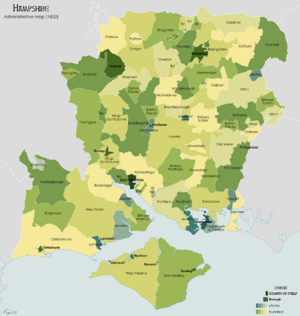History of Hampshire facts for kids
Hampshire is a county in Southern England. It has a rich history with many interesting old buildings and archaeological sites.
The open chalk hills of the South Downs and parts of Salisbury Plain were home to people as far back as the neolithic period (the New Stone Age). These early settlers built hill forts, like Winklebury, and likely farmed the valleys of Hampshire. This area was once part of an Ancient British kingdom. The Celts called it Gwent or Y Went, which described its open hills. This kingdom also included parts of what are now Somerset and Wiltshire. When the Roman invasion of Britain happened, Hampshire was one of the first places the Roman army took over.
Contents
Early Kingdoms and Saxon Times
During the time when Anglo-Saxons settled in Britain, modern Hampshire and the Isle of Wight were first settled by Jutes. The Jutes were a different group from the Saxons and Angles. They formed small kingdoms like Wihtwara (on the Isle of Wight), Meonwara (in the Meon Valley), and Ytene (in the area that later became the New Forest).
However, by the 7th century, the Saxon kingdoms nearby conquered the Jutes. Hamtunscīr was one of the first Saxon areas (called shires) to be officially recorded in 755. This name came from Hamtun, the old name for Southampton.
For about 200 years, Hampshire was the western edge of Saxon England. The Britons fought hard to stop the Saxons from moving further west into Dorset and Somerset. After the Saxons expanded, Hampshire became the heart of the powerful Kingdom of Wessex. Many Saxon kings are buried in Winchester. A famous statue in Winchester honors King Alfred the Great. He was a strong king who brought stability to the region in the 800s.
Norman Rule and Coastal Defenses
After the Norman Conquest in 1066, Norman kings really liked the county. They created the New Forest as a special hunting ground. The Domesday Book, a famous survey from 1086, recorded Hampshire as being divided into 44 smaller areas called "hundreds." These later became 37.
Over many centuries, a series of castles and forts were built along the coast of the Solent. These were made to protect the important harbors at Southampton and Portsmouth. One example is the Norman Portchester Castle, which looks over Portsmouth Harbour. King Henry VIII also built several forts, including Hurst Castle and Calshot Castle.
Southampton and Portsmouth remained very important harbors. They had deep water and good shelter, which made them better than other ports like Poole and Bristol. Southampton has been the starting point for many famous ships. These include the Mayflower, which carried the Pilgrims to America, and the Titanic. Many of the Titanic's crew members were from Hampshire.
Hampshire in World War II
Hampshire played a huge part in World War II. This was because of its large Royal Navy harbor at Portsmouth. There was also a big army camp at Aldershot and the military Netley Hospital near Southampton Water. The county was also close to army training areas on Salisbury Plain.
Supermarine, the company that designed the famous Spitfire fighter plane, was based in Southampton. Because of this, Southampton was heavily bombed during the war. Today, Aldershot is still one of the British Army's main bases.
Name and Administration
In the past, the county was sometimes called "Southamptonshire." You can still see this name on some maps from the Victorian period. The official name of the administrative county was changed from 'County of Southampton' to 'County of Hampshire' on April 1, 1959. A short way to write the name, often used in addresses, is Hants.
The old name also appears in historical records. For example, it's mentioned as the place where many immigrants left for Ellis Island in the United States. It's also in the Commonwealth Instrument of Government, 1653. This was a document adopted by Oliver Cromwell when he became Lord Protector in 1654.
The Isle of Wight was traditionally seen as part of Hampshire for some purposes. However, it has been managed separately from Hampshire for over a century. It got its own county council in 1890. The Isle of Wight became a full ceremonial county in 1974. The island was traditionally divided into two "hundreds": East Medina and West Medina. Today, the Isle of Wight and Hampshire only share a police force. There are no other official administrative links between them.
The towns of Bournemouth and Christchurch are also part of the historic county of Hampshire.
See also


